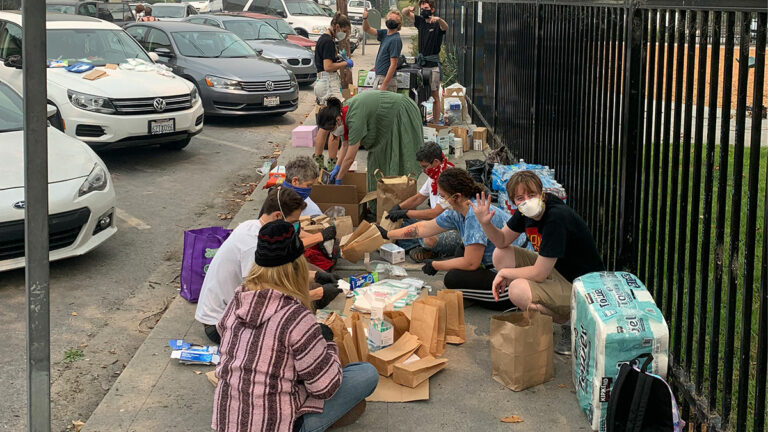Scott Michael Schuhe was already reeling after evacuating with his family and five pets from their Bonny Doon home. The second blow came when he heard how much the two Santa Cruz motel rooms he’d booked eight hours earlier would cost for another night.
The price had almost doubled at the Motel Santa Cruz, from $325 for one room with a single bed and a second with a queen bed, to $299 a night for one room. “We’re all in shock,” Schuhe said. “We were so tired we couldn’t even think.”
Schuhe—along with his son Michael, daughter Heather and soon-to-be son-in-law Drew Mount—drove 12 miles to the one-star motel after their phones lit up at 2:35am Wednesday ordering them to leave. As the fire encroached on the town of barely 2,700 people, they complied, though some of their neighbors stayed behind.
The fire, known as the CZU Lightning Complex, was born of a slew of lightning strikes and dry wind that pushed 77,000 people to evacuate from Santa Cruz and San Mateo counties so far.
While Schuhe knew he couldn’t go home, he also wouldn’t pay $600 to stay another night. The family spent the afternoon looking for a place to stay with their pets—three dogs and two cats—for less.
“Pretty much all of them had jacked up their prices, and the availability was just about nothing,” Michael Schuhe said.
On Saturday night, the tired family sat outside of the downtown San Jose Marriott thanks to a tip from Schuhe’s boss that the hotel had a $99-per-night deal for evacuees, pets and all. Marriott is one of 14 hotels in San Jose with discounted rooms—most $99 a night or less—for people escaping the blazes burning on both the east and west sides of the 10th largest city in the country.
Mayor Sam Liccardo on Friday announced the initiative, called San Jose Cares.
“We know that hotels in other towns or cities may be raising their rates right now, sadly, given the increased demand for a room,” he said. “But we’re going to take the high road here, we’re going to reduce our rates, and make rooms available for a lot of families that need them.”
The initiative, the mayor said, was organized by Team San Jose, which promotes tourism in the city, but was the brainchild of Christopher Thompson, head of the San Jose Knight Foundation. Like the Schuhe family, Thompson evacuated Wednesday from his Ben Lomond home with his partner and two cats, but struggled to find a place to go. Hotels were full, many not prepared for the sudden influx of customers.
“We were going to park at the Scotts Valley Transit Center and sleep there overnight, but the lights were too bright, and we were told you can’t park overnight in the parking lot,” Thompson said. He ended up on the couch in his downtown San Jose condo, which he leases to a gracious tenant who occasionally lets him crash there, per a prearranged agreement.
The fires come during a coronavirus pandemic which has left much of downtown bereft of visitors since mid-March. Hotels and restaurants are limping along, scarcely staffed and partially shut down as they wait for the county to lift business restrictions and for customers to return.
Suddenly, the city is seeing an unexpected economic upshot as evacuees arrive.
Employees at hotels across the downtown said bookings were up significantly Friday. The Marriott, which is connected to the city’s convention center, re-opened floors that had been quiet for months as demand for rooms grew by five times overnight.
The hotel brought back about 50 employees that hadn’t worked since the pandemic started to help with the influx of visitors, according to General Manager John Southwell.
“No industry, other than maybe airlines and cruise ships, have been hit as hard as hotels, because nobody’s traveling,” he said. “It’s great to have people band together like this and for folks to come back to work … after they’ve been off for five months and and say, ‘I want to work to take care of these people.’”
The Marriott was one of the first hotels to jump on board with the discounted rates, after employees asked hotel management to help the evacuees that were showing up in big numbers, Southwell said.
“You looked at the people checking in, all of whom have been displaced, which is tragic, and everybody had their pets,” he said. “It kind of looked like Noah’s Ark …. everybody was just in a bad state from so many places.”
Team San Jose rallied the other 13 hoteliers. Normally, the nonprofit economic development group is busy promoting conventions, plays, concerts and other money-making events for the city. In 2018, that work helped generate $61.7 million in revenue, and nearly $17 million in profit for San Jose.
Those economy-boosting businesses are shuttered for now, but aligning the hotels to work with evacuees was something the group could help with, Frances Wong, Team San Jose’s director of marketing said.
“With these evacuees coming to San Jose in a time of need, I think they’ll remember that San Jose was there for them,” Wong said.
The group got a heads-up mid-week about the growing hotel need from Visit Santa Cruz County, which similarly advances tourism in the region. Its Santa Cruz counterpart was already grappling with the booming hotel room need as the county’s own 4,400 hotel rooms filled up.
“We issued a travel advisory asking that visitors who are in the market to please leave to free up hotel rooms for evacuees and for first responders,” Christina Glynn, communications director Visit Santa Cruz County said. “That, to my knowledge, is unprecedented.”
The hotels in Santa Cruz haven’t uniformly agreed to offer a discounted rate for evacuees. Those details, Glynn said, are up to the individual hotels and motels. Visit Santa Cruz County created a webpage of resources for residents and people fleeing the blaze.
And as many of those families land in San Jose, the temporary tenants’ presence has been felt unevenly among restaurateurs, allowed only to serve customers outdoors or for delivery and takeout orders, per county health department orders amid the pandemic.
As smoke billowed into the city from the surrounding fires Saturday, restaurants felt the push and pull of the downtown filling up more than it has in months versus the air-quality indicators warning people to stay inside for the sake of their lungs.
Diners sat at tables that spilled into the street outside of San Pedro Square Market while a line formed outside of Chacho’s along San Fernando Street. But around the corner, along First Street, many of the city’s smaller eateries felt no uptick at all, managers and owners estimated. If anything, business might have been slower due to the haze, some said.
Scott’s Seafood, which opened in its new location at 200 S. First St. in May, was an exception that felt a boost from the city’s new visitors, according to Sammy Reyes, the restaurant’s general manager.
“Especially the last two nights, I know I met with a few people that were staying at the Marriott, some were staying at the Fairmont,” he said. “It’s been dead, literally there is nothing in downtown … but I think it is going to help a lot having more people down here.”
Some people may stay even longer than a few days or weeks.
As of Monday, Thompson’s home was still intact, but security cameras around the house show ash inches deep all around, so he doesn’t expect it’ll be in a livable condition anytime soon. He’s planning to move into a downtown apartment for now.
Others, like the Schuhe family, are watching their old neighborhood through status updates from those that stayed behind. Heather Schuhe checked a private facebook group for Bonny Doon residents while sitting along Market Street in San Jose Saturday night.
Some of their neighbors have put out fires and helped save pets that were left behind. But the Schuhe family isn’t confident their home was spared over the weekend.
“According to the fire maps it has [been burned], but according to our neighbors, it might not be,” Heather Schuhe said. The family will stay at the Marriott for the foreseeable future and hope for the best when they’re allowed to return home.
“We’re survivors,” Scott Michael Schuhe said. “But when they say ‘Get lost,’ then get lost. We didn’t even think twice.”
Follow continuing in-depth fire coverage here and in our live blog.
























